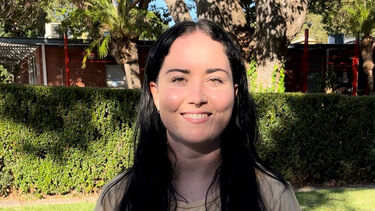
It was an Instagram post that finally hit home for Kira Knuckey. For years she had struggled with period problems, moodiness, anxiety, and thoughts so dark they terrified her. And right there on her screen was the cause – a name for what she was experiencing: PMDD. The relief she felt was indescribable.
“You have this sense that you are not alone,” recalls Kira. “You realise you are not isolated. But then you feel anger because no one has mentioned this condition to you before.
“It’s important to have awareness out there. This is not just my story; it’s the story of others as well.”
Known medically as ‘premenstrual dysphoric disorder’, PMDD is a severe form of premenstrual syndrome (PMS). It causes extreme mood shifts such as depression, irritability, anger and hopelessness. Often it occurs alongside physical symptoms of PMS.
PMDD symptoms come and go on a regular basis. They occur premenstrually, in the weeks before your period, and then ease during the first few days of your period. This is one of the reasons why PMDD is sometimes confused with other health conditions.
It’s important to have awareness out there. This is not just my story; it’s the story of others as well.
Kira’s road to diagnosis began, as it often does, with problematic periods. They were irregular and painful. She had regular bouts of feeling irritable, moody, emotional and weepy. “I went down the rabbit hole of endometriosis in 2014,” she says. “I had a lot of pelvic pain and my GP thought endometriosis sounded just about right.
“I saw a gynaecologist in August 2015 and was booked in for a laparoscopy [surgery]. There were no signs of endometriosis, but they did put in a Mirena [a contraceptive IUD]. I’d had a long struggle in the years up to that to find a contraceptive that worked with my moods.
“In the beginning, it did help a little with that, but my mental health began going downhill. It was so confusing because I remember having three-week-long depressions and one week feeling okay. None of it was making sense to me.”
A psychology student at the time at Curtin University in WA, Kira sought help from the university’s counselling services. “I started seeing a therapist and working on stuff,” she says. “I knew I had depression and anxiety cycles. Sometimes I would go to the therapist, and I was a mess; other times I was fine. There was always this struggle with consistency.
“I blocked a lot of it out and didn’t realise how it was eating into my life. I would think I wasn’t trying hard enough with healthy eating and exercise. It was a vicious cycle. I was in my early 20s, a time when other students were studying easily, having a social life, enjoying independence. Everyone had annoyances or stressful things that happened occasionally. I thought I was highly sensitive.
“PMDD can overlap with symptoms of bipolar disorder and borderline personality disorder. That worried me a lot because I had an uncle with bipolar.
“It’s very confusing to be so up and down and have little balance in the middle. There was hardly any reprieve.”
It was this huge emotional moment because finally someone was listening to me. Gaslighting is so prevalent in this area.
The reprieve arrived in 2018 when a friend, aware that Kira struggled with her hormones and periods, forwarded the Instagram post about PMDD. “That’s when I began tracking my symptoms and I took that to my GP. As she rattled off the symptoms, I was ticking them all off.
“It was this huge emotional moment because finally someone was listening to me. Gaslighting is so prevalent in this area.”
She was prescribed the contraceptive pill and rode a roller coaster over the following few years as she trialled different antidepressants, including SSRIs (selective serotonin reuptake inhibitors) and SNRIs (serotonin and norepinephrine reuptake inhibitors). For a time, she felt suicidal.
“On August 1, 2021, I finally found a combination of medications and care that worked for me,” she says.
“For someone who had until then never had a normal week in my life, this was like a new life. I could finally begin thinking about a future.”
All reasonable steps have been taken to ensure the information created by Jean Hailes Foundation, and published on this website is accurate as at the time of its creation.
© 2023 Jean Hailes Foundation. All rights reserved. This publication may not be reproduced in whole or in part by any means without written permission of the copyright owner. Contact: licensing@jeanhailes.org.au